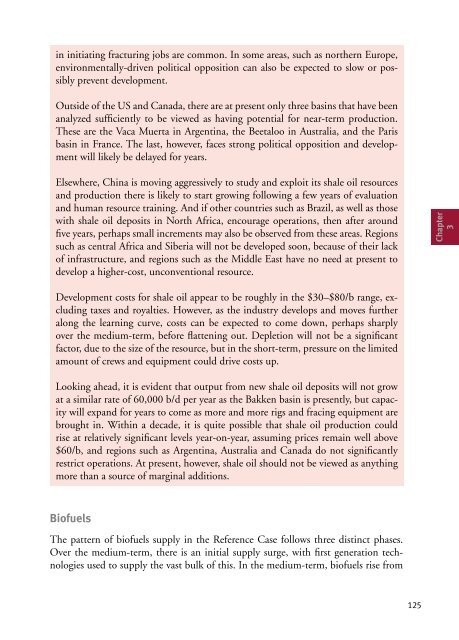Section One
Section One
Section One
Create successful ePaper yourself
Turn your PDF publications into a flip-book with our unique Google optimized e-Paper software.
in initiating fracturing jobs are common. In some areas, such as northern Europe,<br />
environmentally-driven political opposition can also be expected to slow or possibly<br />
prevent development.<br />
Outside of the US and Canada, there are at present only three basins that have been<br />
analyzed sufficiently to be viewed as having potential for near-term production.<br />
These are the Vaca Muerta in Argentina, the Beetaloo in Australia, and the Paris<br />
basin in France. The last, however, faces strong political opposition and development<br />
will likely be delayed for years.<br />
Elsewhere, China is moving aggressively to study and exploit its shale oil resources<br />
and production there is likely to start growing following a few years of evaluation<br />
and human resource training. And if other countries such as Brazil, as well as those<br />
with shale oil deposits in North Africa, encourage operations, then after around<br />
five years, perhaps small increments may also be observed from these areas. Regions<br />
such as central Africa and Siberia will not be developed soon, because of their lack<br />
of infrastructure, and regions such as the Middle East have no need at present to<br />
develop a higher-cost, unconventional resource.<br />
Development costs for shale oil appear to be roughly in the $30–$80/b range, excluding<br />
taxes and royalties. However, as the industry develops and moves further<br />
along the learning curve, costs can be expected to come down, perhaps sharply<br />
over the medium-term, before flattening out. Depletion will not be a significant<br />
factor, due to the size of the resource, but in the short-term, pressure on the limited<br />
amount of crews and equipment could drive costs up.<br />
Looking ahead, it is evident that output from new shale oil deposits will not grow<br />
at a similar rate of 60,000 b/d per year as the Bakken basin is presently, but capacity<br />
will expand for years to come as more and more rigs and fracing equipment are<br />
brought in. Within a decade, it is quite possible that shale oil production could<br />
rise at relatively significant levels year-on-year, assuming prices remain well above<br />
$60/b, and regions such as Argentina, Australia and Canada do not significantly<br />
restrict operations. At present, however, shale oil should not be viewed as anything<br />
more than a source of marginal additions.<br />
Biofuels<br />
The pattern of biofuels supply in the Reference Case follows three distinct phases.<br />
Over the medium-term, there is an initial supply surge, with first generation technologies<br />
used to supply the vast bulk of this. In the medium-term, biofuels rise from<br />
125<br />
Chapter<br />
3
















